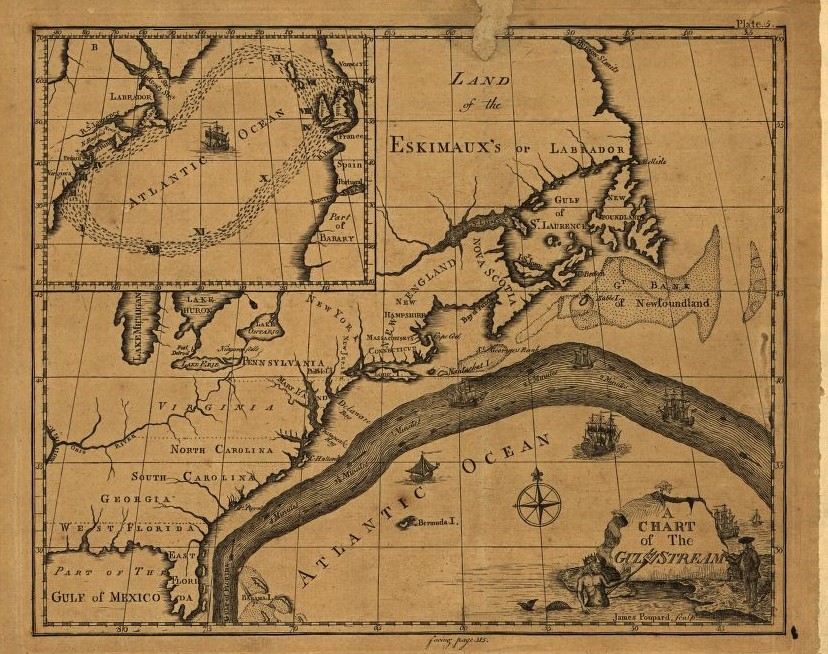The map 'Chart of the Gulf Stream' in an occasional series
depicts a turning point in transatlantic navigation.
Franklin, always an advocate of science and invention,
published this early map of the Gulf Stream in the Atlantic Ocean in 1786.
see Raremaps
Franklin, always an advocate of science and invention,
published this early map of the Gulf Stream in the Atlantic Ocean in 1786.
see Raremaps
From TheCityLab by Laura Bliss
Thanks to the jet stream, westbound flights across the Atlantic take longer than eastbound ones.
In the centuries before air travel, sailors dealt with a related time-sucking natural phenomenon, until a famous American intervened with “A Chart of the Gulf Stream.”
Who made this map?
Benjamin Franklin and his cousin, Timothy Folger, are credited with naming and mapping the Gulf Stream for the first time—the warm, strong ocean current that pushes northeast from the Gulf of Mexico, up the Atlantic coast, towards Europe.
Though there were many editions, the map pictured above was printed by the American Philosophical Society in 1786, and now belongs to the Library of Congress.
Here is another chart from the pen of Benjamin Franklin.
It shows that he realized that the Gulf Stream is actually a loop.
Here
is another chart from the pen of Benjamin Franklin.
It shows that he realized that the Gulf Stream is actually a loop. - See
more at:
http://every-day-is-special.blogspot.fr/2011/05/may-2-2011-you-go-gulf-stream.html#sthash.cjsbbSuF.dpuf
What problem did it solve?
In 1768, Franklin was in London, working as deputy postmaster general for the American colonies.
A visit by Folger, who captained a merchant ship, prompted Franklin to inquire about something peeving him.
Why did it take British mail packet ships so much longer to reach America than it took regular merchant vessels?
It struck Folger that the British mail captains must not know about the Gulf Stream, with which he had become well-acquainted in his earlier years as a Nantucket whaler.
Franklin later quoted his cousin’s explanation like this:
We are well acquainted with that stream, says he, because in our pursuit of whales, which keep near the sides of it, but are not to be met with in it, we run down along the sides, and frequently cross it to change our side: and in crossing it have sometimes met and spoke with those packets, who were in the middle of it, and stemming it. We have informed them that stemming a current, that was against them to the value of three miles an hour; and advised them to cross it and get out of it; but they were too wise to be counselled by simple American fishermen.
In other words, westbound British packet
ships were losing precious time by sailing into and against the warm,
strong current.
Folger sketched out the rough location for Franklin, who soon made prints, along with his cousin’s directions for how to avoid what he dubbed the “Gulph Stream.”
Folger sketched out the rough location for Franklin, who soon made prints, along with his cousin’s directions for how to avoid what he dubbed the “Gulph Stream.”
Who used it?
Franklin passed out copies to those
hapless British packet mariners, but again, they didn’t think much of
the American’s sailing pointers, and apparently ignored them.
With the start of the American Revolution a few years later,
Franklin’s allegiances shifted.He stopped distributing the Gulf Stream map to the British, and instead gave copies to the French, who used it to ship weapons and supplies to their American allies.
After that, knowledge of the stream became “hugely important for transatlantic travel,” says Alex Clausen, a maps specialist at Swann Auction Galleries, where a copy of the map recently sold for about $8,000.
Computer Model of the Gulf Stream Surface Temperature, 2005.
The Gulf Stream is not really a “river in the ocean” as Franklin
thought.
But the waters that make up the Gulf Stream are “channeled” into
a certain direction and speed by many factors-including prevailing winds, the
rotation of the planet, and colder currents around and below the Gulf Stream.
source : Ocean currents, NOAA
Is it accurate?
Compare Franklin and Folger’s 18th-century chart to modern computer-generated models of the Gulf Stream, and they match up remarkably well.
While Franklin himself made observations of the stream on ocean voyages—“I find that it is always warmer than the sea on each side of it, and that it does not sparkle in the night”—the accuracy of the chart is really due to Folger and his inherited whaling knowledge.
Also, Spanish mariners had known about the Gulf Stream since the 1500s.
But Franklin was the one with the good instincts to map it, and that, combined with his general eminence, has landed him with most of the credit.
In 1854, Coast Survey showed the positions and comparisons of observations of temperature in the Gulf Stream 1845 through 1848,
1853 and 1854
(courtesy of NOAA historical)
More than two centuries after this chart was first published, Grumman Aerospace Corporation launched a landmark undersea expedition off the coast of Florida to study the depths of the Gulf Stream.
The submersible’s name? What else: the Ben Franklin.
Links :
- NOAA : Who first charted the Gulf Stream?
- GeoGarage blog : What is the Gulf Stream?
- io9 : Here's the earliest known map of the Gulf Stream, created by Benjamin Franklin



LOC : Charting the Gulf Stream
ReplyDeleteRe: "Here is another chart from the pen of Benjamin Franklin. It shows that he realized that the Gulf Stream is actually a loop." The chart actually shows the migration of herring, not the Gulf Stream, and is an illustration of another article in the same issue as Franklin's Maritimes Observations. The article is by J. Gilpin 1786, Observations on the annual passage of herrings, pp 236-239. The publisher was probably trying to save money by combining the two images. Several people in the past have made the same mistaken interpretation of this image.
ReplyDelete